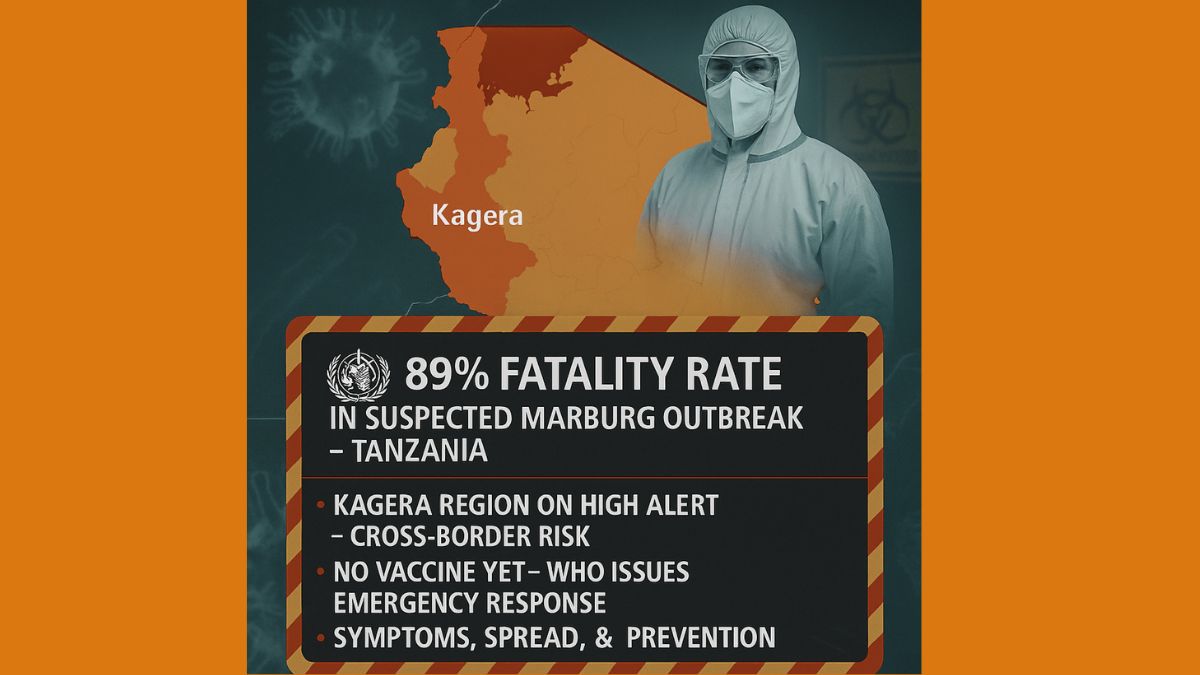Outbreak of Suspected Marburg Virus Disease in Tanzania
Overview of the Situation
Initial Notification
On 13 January 2025, the World Health Organization (WHO) informed its member states about a suspected outbreak of Marburg Virus Disease (MVD) in the Kagera region of Tanzania. The alert was shared via the Event Information Site (EIS), a platform used to rapidly disseminate information about acute public health risks with potential international implications.
Reported Cases and Affected Regions
Reliable reports, received by WHO on 10 January 2025, indicated six suspected cases of MVD in the Kagera region. Five of these cases resulted in fatalities. Symptoms observed among the patients included severe headache, high fever, back pain, diarrhea, vomiting with blood, general weakness, and external bleeding in advanced stages.
By 11 January 2025, the number of suspected cases rose to nine, with eight deaths recorded, reflecting a concerning case fatality ratio (CFR) of 89%. The affected districts include Biharamulo and Muleba. Samples from two patients have been sent for laboratory testing, with results pending official confirmation.
Background Information
Previous Outbreaks in the Region
The Kagera region had previously experienced an MVD outbreak in March 2023, which lasted nearly two months. That outbreak resulted in nine cases and six deaths. The presence of fruit bats, known carriers of the Marburg virus, makes the region particularly susceptible to such outbreaks.
Global Context of MVD
Marburg Virus Disease, caused by the Marburg virus, is a severe and often fatal illness in humans. It is related to the Ebola virus and spreads through direct contact with the bodily fluids of infected individuals or surfaces contaminated by these fluids. The disease poses a high risk to healthcare workers and caregivers, particularly in settings with inadequate infection prevention and control measures.
Public Health Response
National Efforts
- Rapid Response Teams: Tanzanian authorities have deployed national rapid response teams to investigate and contain the outbreak.
- Surveillance Intensification: Contact tracing is actively being conducted in affected areas to identify potential cases.
- Laboratory Testing: Samples from suspected cases are being tested at the National Public Health Laboratory. Mobile laboratories have also been established in the region.
- Treatment Facilities: Designated treatment units have been set up to manage cases and isolate patients to prevent further transmission.
WHO Recommendations
WHO has issued several recommendations to mitigate the outbreak:
Prevention Measures
- Avoid Human-to-Human Transmission: People are advised to avoid direct contact with infected individuals and their bodily fluids. Suspected or confirmed cases should seek care in isolation centers.
- Safe Burial Practices: Families should avoid handling the bodies of deceased MVD patients without proper protective measures.
- Animal-Human Transmission Prevention: Individuals working in environments with fruit bats, such as caves or mines, should wear protective clothing and masks. Consumption of animal products should involve thorough cooking.
Risk Communication
Community engagement is vital for controlling the outbreak. WHO advises:
- Raising awareness about MVD symptoms, risk factors, and preventive measures.
- Encouraging early healthcare-seeking behavior.
- Countering misinformation and promoting trust among communities.
Infection Prevention in Healthcare Settings
Healthcare workers are urged to:
- Use appropriate personal protective equipment (PPE).
- Follow strict hygiene protocols, including handwashing.
- Safely manage medical waste to prevent contamination.
Surveillance and Border Monitoring
Enhanced surveillance at points of entry and borders is essential. Neighboring countries are encouraged to:
- Harmonize reporting mechanisms.
- Conduct joint investigations.
- Strengthen readiness to detect and manage cases early.
Risk Assessment
National Risk
The outbreak’s high CFR and suspected nosocomial transmission (spread within healthcare settings) indicate significant risks at the national level. Delayed detection and ongoing contact tracing highlight gaps in surveillance and response mechanisms.
Regional Risk
Kagera’s location as a transit hub increases the risk of cross-border transmission. The region shares borders with Rwanda, Uganda, Burundi, and the Democratic Republic of the Congo, where population movement is significant.
Global Risk
Although the global risk is currently low, there are concerns about potential spread due to Tanzania’s interconnected transportation networks. Enhanced monitoring at international airports and other transit points is crucial.
Ongoing Challenges
Limited Medical Countermeasures
There are currently no licensed vaccines or specific treatments for MVD. Research into candidate vaccines and therapeutics is ongoing, and outbreaks provide an opportunity for clinical trials to assess their efficacy.
Community Cooperation
Cultural practices, such as traditional burials, may increase the risk of transmission. Community education and involvement are essential to ensuring adherence to safety protocols.
Healthcare System Preparedness
Health facilities must be equipped with adequate resources to handle suspected and confirmed cases. This includes access to safe water, sanitation, and hygiene (WASH) infrastructure.
Recommendations for Control and Prevention
Strengthening Healthcare Facilities
- Ensure that isolation units are adequately staffed and equipped.
- Provide mental health and psychosocial support for patients and families.
- Follow infection prevention guidelines outlined in WHO’s protocols.
Enhancing Cross-Border Coordination
- Strengthen partnerships with neighboring countries.
- Share real-time data to track the spread of the disease.
- Conduct joint training and simulation exercises for outbreak preparedness.
Supporting Research and Development
National and international stakeholders should collaborate to:
- Expedite laboratory testing and genomic sequencing.
- Evaluate candidate vaccines and therapeutics.
Engaging Communities
Targeted awareness campaigns should address high-risk groups, such as traditional healers and community leaders, to reduce the likelihood of disease spread.
Border Health Surveillance
Measures at border points should include:
- Screening for symptoms among travelers.
- Advising individuals with potential exposure not to travel.
- Implementing quarantine protocols for suspected cases.
WHO Travel and Trade Advisory
At this stage, WHO does not recommend any travel or trade restrictions with Tanzania. However, it emphasizes the importance of vigilance and preparedness to prevent further spread of the disease.
ALSO READ – 8th Pay Commission: Massive Salary Hike for 1.14 Crore Government Employees Announced!
Decode the News: Current Affairs Quiz
- What is Marburg Virus Disease (MVD)?
Answer:
Marburg Virus Disease is a severe and often fatal illness caused by the Marburg virus. It belongs to the same family as the Ebola virus and spreads through direct contact with bodily fluids of infected individuals or surfaces contaminated by these fluids. The disease has a high mortality rate.
- Where has the recent MVD outbreak been reported?
Answer:
The recent outbreak has been reported in the Kagera region of the United Republic of Tanzania, specifically in the districts of Biharamulo and Muleba.
- What is the case fatality ratio (CFR) of the current outbreak?
Answer:
The current outbreak has a case fatality ratio of 89%, with nine suspected cases and eight deaths reported as of 11 January 2025.
- What symptoms are associated with MVD?
Answer:
Symptoms of MVD include severe headache, high fever, back pain, diarrhea, vomiting with blood, body weakness (malaise), and, in advanced stages, external bleeding from orifices.
- How is MVD transmitted?
Answer:
MVD is transmitted through direct contact with the blood, saliva, vomit, urine, feces, or other bodily fluids of infected individuals. It can also spread via contaminated surfaces or through prolonged exposure to infected fruit bats, the primary reservoir of the virus.
- What public health measures have been taken to contain the outbreak?
Answer:
Measures include deploying national rapid response teams, intensifying surveillance and contact tracing, establishing treatment units, and conducting laboratory testing. Mobile laboratories have also been set up in the affected region.
- Why is the Kagera region prone to MVD outbreaks?
Answer:
The Kagera region is endemic to fruit bats, the natural reservoir of the Marburg virus. Additionally, the region\u2019s role as a transit hub with significant cross-border movement increases the risk of outbreaks and spread.
- What is the current risk assessment of the outbreak?
Answer:
- National risk: High, due to delayed detection, high CFR, and potential nosocomial (healthcare-associated) transmission.
- Regional risk: High, because of cross-border movement to Rwanda, Uganda, Burundi, and the Democratic Republic of Congo.
- Global risk: Low, as there is no confirmed international spread yet.
- What preventive measures are recommended for individuals?
Answer:
- Avoid direct contact with infected individuals or their bodily fluids.
- Seek care in health facilities for suspected cases.
- Practice safe burial protocols for MVD-related deaths.
- Wear protective clothing when in areas inhabited by fruit bats.
- Thoroughly cook all animal products before consumption.
- What is the status of vaccines or treatments for MVD?
Answer:
There are no licensed vaccines or specific therapeutics for MVD. However, several candidate vaccines are under development, and outbreaks provide opportunities to assess their safety and efficacy.





